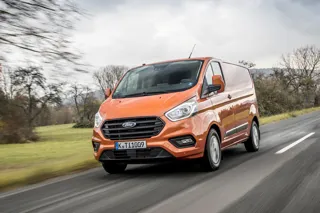By Matthew Davock, director of commercial vehicles at Cox Automotive
Manheim witnessed a very different LCV marketplace during Q1 2022.
The period saw clear overall price robustness, leading to vans achieving £1,249 or 12% more than Q1 2021.
Age and mileage dynamics also drastically rose, with age being three months or more, and mileage being 7,100 more on average compared to the same period in 2021.
Price juggling factors for buyers continue to shine through.
Compared to pre-pandemic averages, Euro 5 van prices cost on average 71% or £2,252 more today, at £5,311. Euro 6 van prices achieved 58% or £4,366 more on average, at £14,063.
Given these strong price dynamics, cash flow remains the biggest challenge for dealers today. For example, a 150-van pitch would cost a dealer more than two million pounds today, just for stock alone.
Cautious approach to used stock purchasing
Despite increasing wholesale key indicators, retail market feedback reports a significant reduction in retail sales, enquiries, and activity, compared to the last 18 months of super-heated market and buoyancy.
Market and business confidence slowed as buyers adopted a cautious approach to purchasing used stock.
The first quarter suggests we are operating in a retail segment that has a pre-pandemic feel to it.
From November 2021, 68% of dealers reported extremely slow retail conditions.
Dealers yearned for improved retail conditions during Q1 2022, but that didn’t happen.This equated to much lower enquires than the averages witnessed earlier in the pandemic.
Recently, dealers are facing significant price increases in turning around ‘pandemic-worn’ vans to a retail standard.
Prices for paint, vehicle adaption and mechanical parts have all rocketed, while dealers report a 32-38% increase alone in preparation costs.
Patience, caution, and old stock turn
Buyers and sellers have experienced 18-months of continuous growth and demand.
Once a marketplace shows some signs of softening for the first time, defensive mechanisms kick in.
This was confirmed in Q1, as buyers adopted the following three defensive behaviours: patience, caution, and old stock turn focus.
Our data showed September 2021 as the performance peak of the whole pandemic period for price and conversion rate performances, but this was two months before market conditions started to soften.
Some of the performance guides were playing catch up and we saw significant rises both in September and October guide prices.
This was off the back of market and retail factors beginning to slow.
These factors led to buyer caution about what and how many vans to stock.
A recent Manheim survey suggested that 63% of dealers stocked 45% less volume of vans on average, but healthy profit margins were an important factor.
These all brought softening to Manheim auction conversion rates, with 6/10 (67.2%) of vans selling for the first time, compared to 8/10 (82.7%) during the pandemic.
Market perfectly balanced for Q2
Poor March 2022 new van registrations should inject some positivity into used retail activity, but strong used van prices will persist.
Business confidence and retail price patience will be crucial as we enter a seasonal market period in quarter two, and de-fleeted market growth won’t be as forthcoming as previously hoped.
Q1 2022 data reported a 23.6% decline in new van registrations compared to Q1 2021, as global supply challenges hampered pandemic recovery.
However, there was exceptional demand from significant fleet orders for new electric vans in quarter one, with 4,297 units registered.
This represented a 68.9% increase versus Q1 2021 and the highest recorded market share on record, at 5.8% of the total vehicle registration parc.
2022 could still be one of the strongest years on record for used and new van transactions
The number of vans that have been ordered, but not yet built for the UK market, is as much as 405,000.
If manufacturers can accelerate these production volumes, 2022 could still be one of the strongest ever new van markets on record for the UK.
While the new van market was not as affected by the semiconductor shortage as the new car market, we witnessed 36 months of leasing contract extensions, as well as an ageing parc of around 2.5 million vans, averaging nine years old.
The resulting semiconductor crisis and ‘pandemic-worn’ vans encouraged many fleets, leasing and rental businesses to produce larger orders.
Manheim data shows that used vans cost 72% more on average, compared to pre-pandemic averages.
Therefore, it’s understandable why many buyers are looking at purchasing new vans instead.
For example, a new van will cost a buyer less per month in average monthly payment terms today, compared to a one-to-two-year-old used one, based on current finance averages and packages.
Used van prices are also supported by significant prices increases on new ones.
New commercial assets are costing 15-18% more on average, than 2021 price levels.
This has created a healthy retail gap between new and used price dynamics, meaning that the used market will remain supported, as manufacturers are taking a very aggressive stance on new van pricing today.”





















Login to comment
Comments
No comments have been made yet.